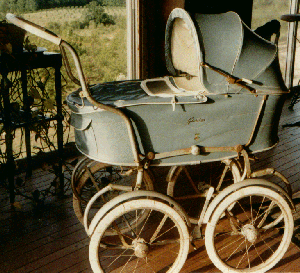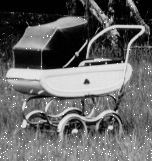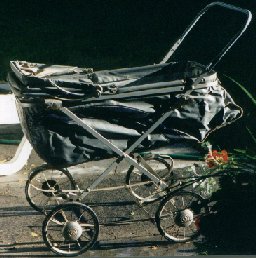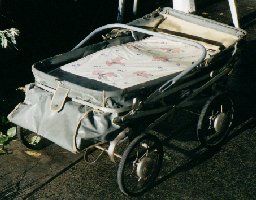 |
|
 |
|
The Virtual Pram Museum's Carriage Gallery
Carriages circa 1950
|

|
Giordani (Italy)
This beautiful little carriage has big wheels out of proportion to the elegant body shape, giving the whole unit charming lines. It would't be accurate to say that the frame actually folds compactly, but the wheels do detach, and the handle folds.
The body is removable and has rigid carry handles inside the bed, as well as a wire under structure to keep the bed stable when using it alone. This carriage was The Pram Museum Heir's bed for the first few weeks of her existence.
|
Features:
- blue/green vinyl body
- white interior
- round hood
- very large wire spoked wheels
- white rubber tires
- interior carry handles for carriage body
- interior pockets
- reinforced base for use as bassinet
- Wheels detach
- body reverses
- handle folds
 |
Stroll-O-Chair, USA (1951)
With its nicely curved steel body, this Stroll-O-Chair is reminiscent of its English cousins. The frame design is almost identical to that used in the 1940s, and, in fact, changed very little over the years until the company went out of business in the 1990s.
The carriage bed can be reversed to face either way, and, as is the case with the earlier mode, the bed can be detached to be used as a car bed (no longer recommended!) or a bassinet. Unlike earlier models, the hood here is a synthetic fabric with a vinyl waterproof lining -- it's a bit more elegant, and also more like those British prams.
|
Features:
- white painted steel body
- wire spoked wheels
- white rubber tires
- navy blue waterproof fabric hood
- wheels detach
- handle folds
- carriage body reverses
- base for use as bassinet
Unknown Manufacturer, USA (1950s)
Americans families became more and more mobile in the 1950s, which resulted in a demand for lighter weight, foldable buggies like this sensible, useful model.
 |
The "boodle" foot is a panel which unsnapped to make more room at the foot of the bed. This neat design feature allowed either more storage, or for extra room for growing baby legs.
The carriage bed unsnaps from the frame, and can be reversed so that the baby faces the path ahead. The bed also detaches from the frame, allowing it to be used as a car bed -- a practice which is no longer recommended! |

|
Features:
- dark grey vinyl buggy
- boodle foot
- lightweight, collapsible
- wire spoke wheels
- black rubber tires
Top
 Home Page Home Page
© 2000 . All rights reserved.

|










